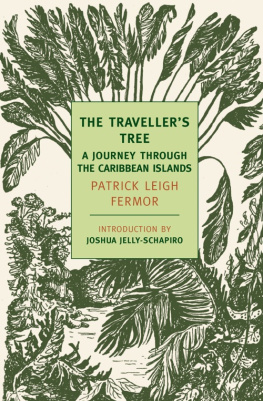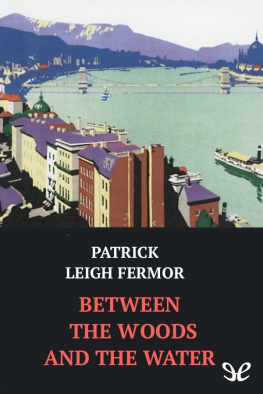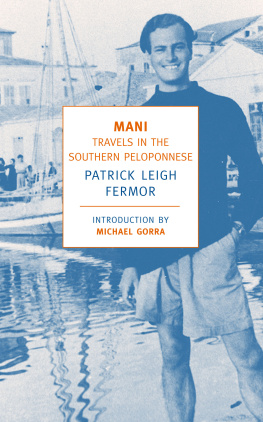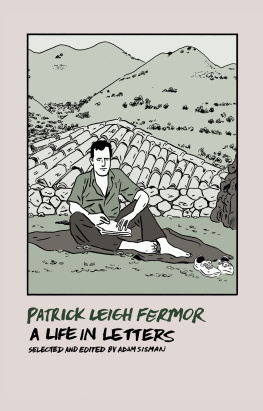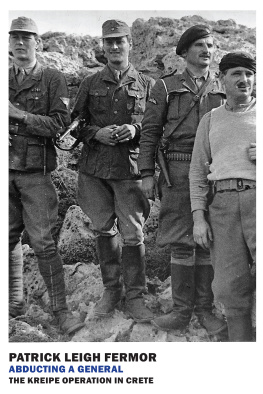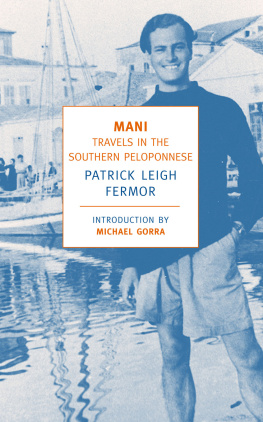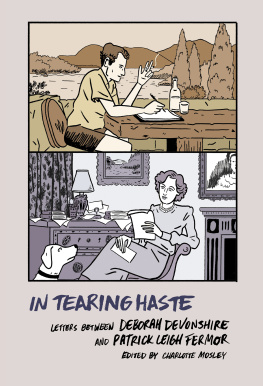PATRICK LEIGH FERMOR (19152011) was born of Anglo-Irish descent and raised in Northamptonshire and London. After his stormy schooldays, followed by the walk across Europe to Constantinople that begins in A Time of Gifts (1977) and continues through Between the Woods and the Water (1986), he lived and traveled in the Balkans and the Greek Archipelago. His books Mani (1958) and Roumeli (1966) attest to his deep interest in languages and remote places. In the Second World War he joined the Irish Guards, became a liaison officer in Albania, and fought in Greece and Crete. He was awarded the DSO and OBE. He lived until the end of his life in the house he designed with his wife Joan in an olive grove in the Mani. He was knighted in 2004 for his services to literature and to BritishGreek relations.
JOSHUA JELLY-SCHAPIRO is a doctoral student in geography at the University of California, Berkeley. He has written for The Guardian, The Believer, The Nation, Foreign Policy, and The New York Review of Books, among other publications.

THE TRAVELLERS TREE
A Journey Through the Caribbean Islands
PATRICK LEIGH FERMOR
Introduction by
JOSHUA JELLY-SCHAPIRO
Photographs by
A. COSTA
NEW YORK REVIEW BOOKS

New York
CONTENTS
Introduction
1.
I N THE late summer of 1947, Patrick Leigh Fermor, OBEhero of the Irish Guards, leader of the Cretan resistance, famed kidnapper of the Nazi General Kreipeboarded an ocean liner in Southampton, bound for Central America. With him were Costa, the Greek painter whod suggested the trip, and Joan Eyres-Monsell, an English photographer whom Fermor had met in Cairo during the war and whom he would marry two decades later. The plan was to spend six months in the Greater and Lesser Antilles.
The book Paddy came home to write you now hold in your hands. When it was published in 1950, The Travellers Tree won favorable reviews and the Heinemann Literary Award, beginning the course of a lifes work that would come to see Leigh Fermor widely acknowledged, for much of a storied life still thriving into its tenth decade, as our Greatest Living Travel Writer.
However deserved, the title is a somewhat dubious onenot least because his oeuvre includes works too varied to be so easily classified. Among them are a crystalline meditation on life in the Trappist monasteries of France (A Time to Keep Silence, 1957), a lyric pair of accounts of rambling by foot and mule through his adopted Greek homeland (Mani, 1958; Roumeli, 1966), and most famously, A Time of Gifts (1977) and Between the Woods and the Water (1986), those bibles of backpacking seekers everywhere in which Leigh Fermorwriting thirty years after the events described through the gilded haze of memory (and naturally including, as he has admitted, a few conjured characters and events)recounts setting off from England in 1933, at the age of nineteen, for a two-year walk clear across Old Europe from Rotterdam to Istanbul.
Leigh Fermors best-known works are often described as odes to a prelapsarian world sundered forever from us by the war. The Travellers Tree, penned right after the trip it describes, is something else entirely: a report on the birth pangs of our postwar world just then coming to be. Brimming with the gratitude for life particular to a European generation that had just buried half its members, Leigh Fermors book may well be but a humble chronicle whose ultimate purpose is to retransmit to the reader whatever interest and enjoyment we encountered. It is also a book suffused with the wondering spirit of an engag asking after what will become of these New World islands which are passing from Old Europes imperial shadow. This makes the book notable in Leigh Fermors oeuvre for forcing him to engage with the legacy and fact of the fading empire whose highest honors he had just then received.
Writing a travel book about the Caribbean is not like writing a travel book about just anyplace. As Leigh Fermor notes: The region of Antillea existed in the minds of Europeans long before the Antilles were discovered. From the moment Columbus gazed out from the Santa Maria at what he mistook for an Indie and wrote of the most beautiful land that human eyes have ever seen, the Caribbean has been the object of fantasies projected from without: islands quickly shorn of their native peoples, who were then replaced with societies constructed, over the course of four centuries, for the express purpose of providing sugar for European tables. From the start, the Caribbean and its literature have been tied to imperial endeavor, from English ur-texts like Walter Raleighs Discovery of Guiana (1595), straight through to Evelyn Waughs dyspeptic account, in Ninety-Two Days (1934), of traipsing through jungles first claimed for England by Raleigh. Even the Trinidad-born V.S. Naipaul, apparently at pains to adopt a worldview more English than England, piles on this imperial scorn: in The Middle Passage (1962) he describes the Caribbean as half-made societies.
Paddy Leigh Fermor, British travel writer par excellence, owes much to the long-standing aims of a tradition seeking to make a place called Abroad understandable for British readers on their damp isle. Where Waugh, though, is prone to homey descriptionsMonte Carlos casino is like Paddington station in the first weeks of Augustthe part-Irish Leigh Fermor takes no comfort from happening on reminders of Englishness abroad. Arriving early in his trip to Barbadosthe only of the West Indies to remain under continuous English control from the sixteenth century to the twentiethhe writes with vivid distaste of a place whose culture reflects most faithfully the social and intellectual values and prejudices of a Golf Club in Outer London. This supremely elegant writer, for whom judgments of style are always moral as well, is only too happy to wave Bimshire goodbye. Looking backwards, we could almost see, suspended with the most delicate equipoise above the flat little island, the ghostly shapes of those twin orbs of the Empire, the cricket ball and the blackball.
Sanguine about the passing of the empire, Leigh Fermors questions concern what will become of these islands: How will the raw legacies of racial slavery be salved? Will these proximate islands, with the end of colonial rule, figure out how to confederate or relate across the divides of language and history? Or will they merely fall under the sway of a new American hegemon whose might was perhaps felt less strongly in new military bases than the incipient creep of Coca-Cola advertisements, frigidaires, wireless sets and motor-cars? These are the same questions that would preoccupy the generation of Caribbean leaders and thinkers, just then coming of age, who would seek in ensuing decades to forge a new regional society.
2.
Among the challenges of writing a travel book about a group of islands is the lack of inbuilt narrative thread afforded, say, by walking across Europe: a mode of travel and writing in which the contiguous relation of one place passed through to the next is at least partly inherent. Traveling through the Antilles, Leigh Fermor has no such luxurybut this, he thinks, is only fitting: Short of writing a thesis in many volumes, only a haphazard, almost a picaresque approach can suggest the peculiar mood and tempo of the Caribbean and the turbulent past from which they spring. And so it is that our party hops among the regions islands by steamship, airplane, and schooner. Starting mid-chain in Guadeloupe, they sail through the French outer islands of Dsirade, the Saints, and Marie-Galante; hop by plane down to Martinique; double back northward from there to the English isle of Dominica, its blue-green peaks wedged as if on accident between its two French neighbors. From Dominica, they fly off south and east to the little coral isle of Barbados, set a ways off in the Atlantic from the Antilles volcanic chain; and on to vibrant Trinidad, hard by the South American main; and then to its pacific neighbor of Grenada, before flying northward in a drastic burst of speed through the Leeward islands in order to dawdle and still to have a little money left over in the Greater Antilles. With brief stops in St. Lucia (the most French of the British Indies), Antigua (heavy with melancholy and the allusions of ancient fame), and St. Kitts, they travel by sail (this, we all agreed, was the proper way to travel in the West Indies) through the odd and monied Dutch isles of St. Eustatius, Saba, and St. Martin, where their journey attains its nadir awaiting a plane to the Virgin Island of St. Thomas (a possession of the Dutch before they sailed off to found New Amsterdam and left it to the Danes, who in 1917 deeded it to the United States), before finally, in flying on to Puerto Rico, they reach the Greater Antillesthe last of the small islands, with their easy and familiar values slipping out of control. After lingering in Haiti, Hispaniolas western halfrecalling the singular tale of a nation born from historys only victorious slave revolution; toasting the incomparable verve of haute Haitian society in Port-au-Prince (the white tropical suits, the dark heads and hands the great elegance of movement and gesture a room full of sable Venuses); detailing a few fascinated weeks immersed in vodou and what its rites represent (the memory of Africa; unity against a cruel and hostile world; survival; the mystery, the warmth, the drums and the dances)they take their journey to Jamaica, and to its end in Cuba.

